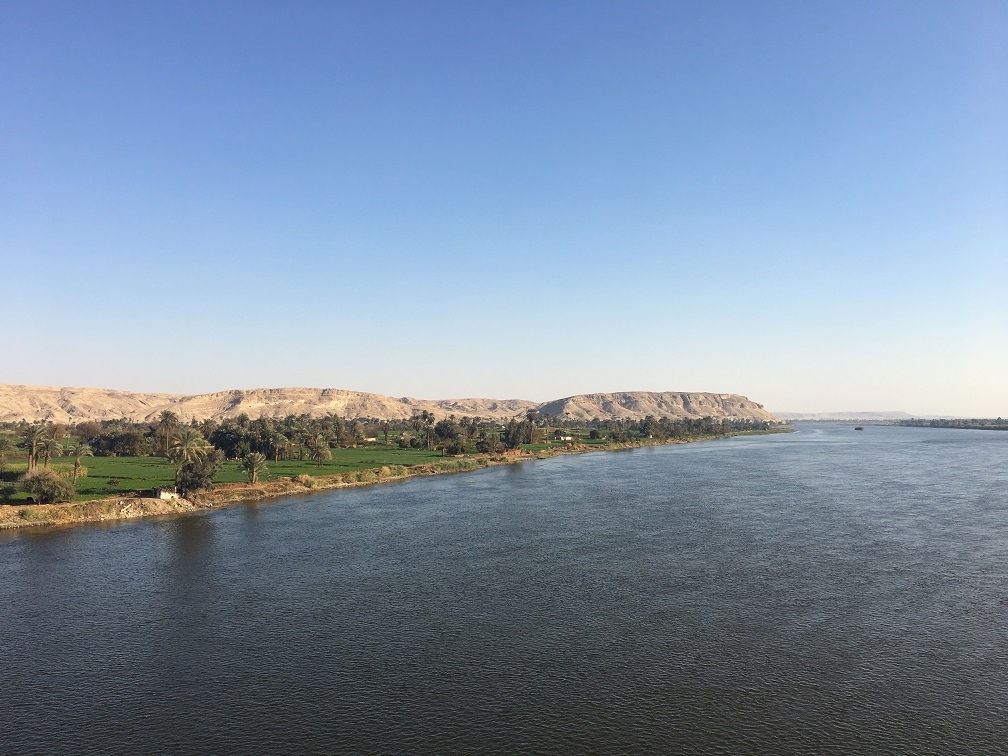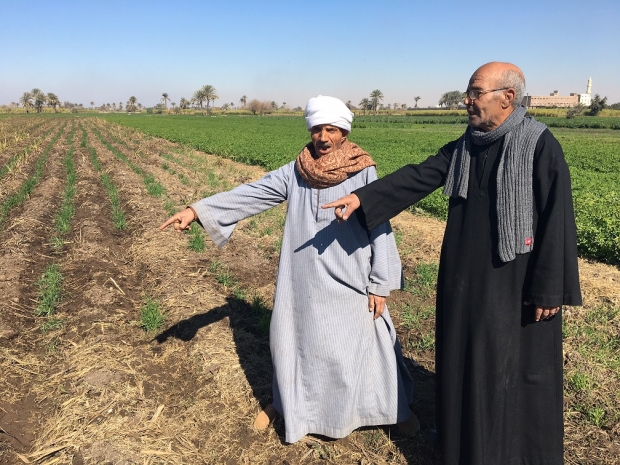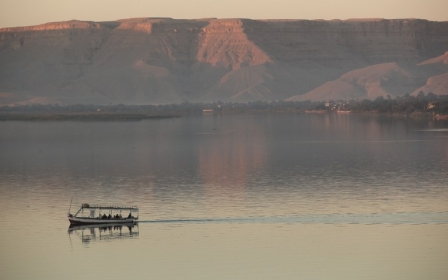Egyptian farmers fear drought, and dam: 'Without the Nile there is no life'

MINYA, Egypt - In his small straw cottage, farmer Mostafa Metwally waited for his turn to irrigate his "thirsty" half-feddan (acre) of land in Quloba village, in the Upper Egyptian province of Minya.
The 70-year-old farmer plants sugar cane and wheat in the winter season.
"My harvest is no longer as profitable as before due to the current shortage of water," a problem he said is not new, but goes back 20 years.
Farmers in the southern province complain about a severe shortage of water that is expected to escalate when Ethiopia finishes the construction of the $4.1 billion Grand Ethiopian Renaissance Dam (GERD), which is expected to be completed by July.
Mohamed Nasr Allam, former minister of water resources and irrigation, told Middle East Eye that the government is responsible for determining each farmer’s share of the Nile water. Protests increased after the 2011 revolt, so government officials gave farmers more than their usual share in water to avoid unrest, which led to a drop in water reserves, according to Allam.
'Black days' ahead
Two farmers pointed to a small canal that used to transfer water from the Nile to their lands. It is now dry and overfilled with garbage, sewage water and other agricultural waste.
Egypt is already under the water poverty line, with a yearly shortage of over 20 billion cubic metres. The United Nations predicts that Egypt will be approaching a state of “absolute water crisis,” by the year 2025.
Metwally fears that more "black days" are coming ahead if Ethiopia finishes constructing its dream GERD.
"If they really finish the dam, it will definitely be our death,” he said as he held some dry soil in his hand.
'If they finish the dam, it will definitely be our death'
“If this is the situation now, what it will look like in few years?” he added.
Adel Adly, a 66-year-old landowner of 25 acres, said that the Nile was “more precious” than his two sons.
"Without it [the Nile] there is no life in Egypt," he said.
Adly strolled proudly through his farm, which was decorated with tall sugar cane stems.
Wearing a simple black jalabiya and a heavy scarf wrapped around his neck to keep him warm in the cold weather, the farmer anxiously spoke about his fears.
"We are worried about the future; we fear a drought that would leave our land sterile.”
In the small and narrow dusty passage separating the farms, a small boy sat on a cart pulled by a gaunt donkey, grabbing Metwally’s attention.
"Even the animals are thirsty and hungry, the situation is difficult," he said.
Metwally's two buffaloes were lying in the sun a few metres away from his donkey. They help him carry tools and other material from his house to the farm.
For Adly, Metwally and other farmers from older generations in Upper Egypt, the Nile is called Bahr, meaning sea in Arabic.
Mohsen El Gibaly, a 64-year-old farmer, is sitting in an old-fashioned salon in a two-storey newly renovated house that belongs to his grandfather. Gibaly's family owns more than 100 acres in Quloba.
"We call the Nile bahr, and we call the sea the Nile," he said as the three farmers laughed loudly remembering their 50-year friendship. "I still don't know what the source of that [saying] was.”
The ancient Greek historian Herodotus wrote around 450 BC that Egypt was “the gift of the Nile,” referring to how the river water replenished Egypt’s soil, creating green fields for the people.
Water feud
Leaders in the village meet in Gibaly’s house to settle any irrigation disputes, which in some cases, can even lead to murder.
The Ministry of Irrigation determines and distributes irrigation times. They work from a small one-storey building with the Egyptian flag painted on the outside wall in Quloba and other villages.
On 5 January, two farmers were killed in a feud that escalated to exchanging gunfire between two families over who had priority to irrigate their farm in Minya's Maghagha city, a local newspaper reported.
Social development officer in the Nile Basin Initiative, Mohamed Mohieddin, explained the origins of such feuds over irrigation and the importance of agriculture in the country.
"Agriculture employs a third of the nation and if there is a water shortage, there will be no agriculture,” he said, pointing out that 57 percent of Egypt’s population lives in rural areas.
"Agriculture consumes 85 percent of Egypt's share of water, so any shortage will directly affect irrigation, which will consequently affect relations between farmers. You can imagine strife in every village,” he added.
In Gibaly’s living room, piles of books were scattered on two sofas in front of a library carved into a wall.
“I started to read to put an irrigation plan for [our] grey future. We may resort to drip irrigation,” he said, adding that they had to be very cautious with their current use of water, as if they were already inhabiting a barren desert.
Egypt’s lion share of the Nile
Treaties dating back to Britain's colonial rule in the region, stipulated that only Sudan and Egypt have the right to the use of Nile waters, with Egypt receiving the lion's share of 55.5 billion cubic metres of water. The gap between the needs and availability of water is over 20 billion cubic metres.
Some farmers in Quloba and many other villages in Minya resorted to irrigation by using ground water in dealing with the shortage. With the Nile a few metres away from their farms, they install dozens of metal pumps to extract groundwater to irrigate the lands, but this practice leads to soil erosion, forcing farmers to build their homes on agricultural land. Dozens of houses built with cement blocks can be seen along the green plantations.
Ethiopia’s national dream
Ethiopia, the source of the Blue Nile which joins the White Nile in Khartoum and runs on to Egypt, is constructing the dam to boost its electricity generating capacity from 2,060 MW up to 6,000 MW, to meet the needs of most of its citizens.
Around 70 percent of the population of 99 million suffer from long power cuts because they currently live in areas that are not covered by the country’s electricity network.
In July 2016, GERD project manager Simegnew Bekele told Egyptian reporters visiting the dam’s site for the first time that their intentions were only positive.
"Ethiopia has no intention to deprive Egypt from its water shares. We only want to combat our common enemy, which is poverty," he said.
GERD would enable the country to sell electricity to its neighbours, including Sudan, South Sudan, Djibouti, Kenya, and even Egypt, according to government estimates.
Yet these hopes of development clash with Egypt's fears of possibly creating drought in Quloba village and other villages that depend solely on agriculture for survival.
Egyptian media coverage of the construction of the dam always reflects fear, mistrust, and doubt about its impact on Egypt’s share of the Nile water.
Ethiopian journalist Solomon Gosho downplays Egyptian fears.
"The official position here is that the water volume will decrease for a short period of time, and it is scientifically proven that the risk is manageable, it will not lead to drought in Egypt,” Gosho, who writes for Ethiopian newspaper The Reporter, told MEE.
He added that the damn is being built mainly to generate electricity, not to store water.
Points of contention
In March 2015, following several years of disputes and failed negotiations, Egyptian President Abdel Fattah al-Sisi signed a preliminary agreement with Ethiopia and Sudan in Addis Ababa.
The deal was based on a declaration of principles to ensure that the construction of the dam would not harm other countries downstream and would compensate them should it negatively affect their interests. Yet it did not resolve several points of contention like Ethiopia's right to construct the dam without coordination with Egypt, a move the Egyptian government sees as a violation of the 1959 treaty.
Sisi stressed his country's dependence on Nile waters, following the agreement.
"You will develop and grow and I am with you, but be aware that in Egypt the people live only on the water that comes from this river," he said.
Allam, is an outspoken critic of the agreement with Ethiopia, and he warned against the "negative and catastrophic effects" of the dam.
"Filling the Renaissance Dam’s reservoir will cause the lake behind Egypt’s Aswan High Dam [Lake Nasser] to reduce sharply.”
The Aswan high dam, located at the border between Egypt and Sudan, started operating in 1971 in a bid to save Egypt from floods, generate electricity and more importantly store water for periods of drought.
However, critics say that while the dam has generated power and prevented large-scale flooding in many areas, it has also created more problems, like reducing the fertility of the soil in the delta.
Allam expects that GERD will lead to the erosion of millions of acres of agricultural land, a drop in the amount of electricity produced by the Aswan Dam, and a crisis in drinking water.
“The High Dam can only be filled if there are no dams before it, if there is a dam before it, it will turn into a tap that you have no power to open. This has catastrophic effects on our national security,” he warned.
For the older generations, leaving the land and looking for other types of unemployment is something that is considered shameful, and very few dare to do it. But 37-year-old Mohamed Abdel Hafiz, who manages his family farming business from abroad, thinks about selling his family’s land and quitting farming every day, especially with the Ethiopian dam almost complete.
A few months ago Hafiz left Egypt to work as an accountant in Saudi Arabia, as his income had sharply dropped due to the deteriorating economy. He now manages his farm from Riyadh.
"We used to earn our living as farmers, now we spend all our money on it without any profits.”
New MEE newsletter: Jerusalem Dispatch
Sign up to get the latest insights and analysis on Israel-Palestine, alongside Turkey Unpacked and other MEE newsletters
Middle East Eye delivers independent and unrivalled coverage and analysis of the Middle East, North Africa and beyond. To learn more about republishing this content and the associated fees, please fill out this form. More about MEE can be found here.








